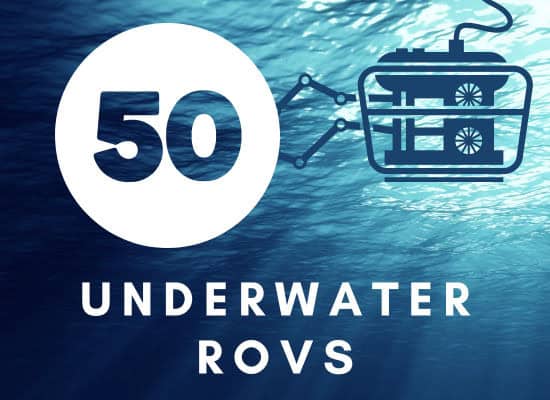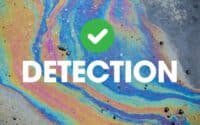Top 50 Innovative Uses for Underwater ROVs

In the competitive and ever-evolving maritime industry, Underwater Remotely Operated Vehicles (ROVs) are revolutionizing how we maintain, inspect, and safeguard our fleets. These technological marvels offer a glimpse into the future of maritime operations, where precision, safety, and efficiency reign supreme. From performing intricate repairs beneath the waves to ensuring the integrity of ship hulls, ROVs are not just tools but game-changers that redefine the boundaries of what’s possible at sea.
* Please send feedback/suggestions to editor @ shipuniverse.com
Explore our top 50 innovative uses for underwater ROVs. Initially, we concentrated on applications related to ships, but the vast potential of ROVs compelled us to include a wider array of uses. This list showcases how ROVs are changing the game, not just for maritime operations but across diverse fields, from environmental research to underwater repair and beyond.
For edits or inclusion please email editor @ shipuniverse.com
1. Hull Inspections
Underwater ROVs are pivotal for conducting thorough hull inspections. They allow shipping companies to assess the condition of a ship’s hull in real-time, identifying issues like fouling, corrosion, or damage without the need for dry docking. This not only saves on costs and downtime but also enhances vessel performance and fuel efficiency.
2. Propeller Cleaning and Inspection
ROVs equipped with cleaning attachments can perform propeller polishing and cleaning underwater. This service improves propulsion efficiency, leading to significant fuel savings. Additionally, regular propeller inspections help detect and mitigate wear or damage, maintaining the operational integrity of the vessel.
3. Underwater Repairs and Maintenance
Performing minor repairs and maintenance tasks underwater is now more feasible with ROVs. Equipped with various tools, these vehicles can execute tasks ranging from patching holes to cutting damaged netting, reducing the need for dry-dock repairs and extending the service intervals for vessels.
Did you know? The Blueye X1 and X3 can both be fitted with advanced manipulator arms.
4. Search and Recovery Operations
ROVs are invaluable for search and recovery missions. They can swiftly locate and retrieve objects that have fallen overboard or inspect underwater structures for lost cargo. This capability is crucial for minimizing the financial loss associated with missing assets and ensuring the safety of maritime operations.
5. Security and Surveillance
With piracy and unauthorized access being a concern in certain regions, ROVs offer an additional layer of security. They can be deployed to inspect and monitor the underwater portion of a vessel or a port’s infrastructure, ensuring there are no unauthorized activities or threats present.
6. Environmental Monitoring and Protection
ROVs play a crucial role in environmental monitoring by assessing the impact of maritime activities on marine ecosystems. They can collect water and sediment samples near shipping lanes or inspect for accidental discharges, helping companies comply with environmental regulations and protect marine life.
7. Anchor Line and Chain Inspection
Regular inspections of anchor lines and chains are essential for ensuring the safety and reliability of mooring systems. ROVs can efficiently perform these inspections, identifying wear, corrosion, or damage. This proactive approach prevents anchor failures and potential accidents, especially in harsh weather conditions.
8. Dock and Pier Inspection
Underwater ROVs are instrumental in inspecting docks, piers, and other port infrastructure. They can identify structural issues, damage, or obstructions that could impact shipping operations. These inspections are crucial for maintaining port safety and operational continuity.
9. Cable and Pipeline Surveys
In areas where underwater cables and pipelines cross shipping lanes, ROVs are used for regular surveys to ensure their integrity and avoid potential hazards. These surveys are vital for preventing disruptions in telecommunications and energy supply, which could have significant economic implications.
10. Iceberg and Debris Monitoring
In regions prone to icebergs or where debris could pose navigational hazards, ROVs offer a safe and effective monitoring solution. They can assess the size, trajectory, and potential threat of icebergs or underwater debris, aiding in route planning and preventing collisions.
11. Ballast Water Tank Inspection
Regular inspection of ballast water tanks is crucial for maintaining vessel stability and compliance with international marine environmental laws. ROVs offer a non-intrusive method to inspect these tanks for integrity, sediment build-up, and invasive species, ensuring ships meet environmental standards without the need for emptying the tanks.
12. Underwater Welding and Cutting
Advancements in ROV technology now allow for underwater welding and cutting operations to be conducted remotely. This capability is especially useful for emergency repairs or modifications to ships and port infrastructure, reducing downtime and eliminating the need for dry docking or diver intervention.
Did You Know? High-end underwater ROVs are now surprisingly affordable. The ROV line from Blueye starts at just over 5k.
13. Salvage Operations
ROVs are invaluable in salvage operations, allowing companies to assess sunken vessels and cargo and plan their recovery. Equipped with high-definition cameras and lifting capabilities, ROVs can locate, inspect, and assist in the retrieval of valuable assets from the ocean floor, making salvage operations more efficient and less hazardous.
14. Navigational Aid Inspections
Maintaining navigational aids, such as buoys and markers, is vital for safe maritime navigation. ROVs can inspect these aids for damage, wear, and functionality, ensuring they are in proper working condition and accurately positioned, which is essential for the safety of all maritime traffic.
15. Underwater Archeology and Shipwreck Exploration
While not a traditional maritime shipping activity, underwater archeology and the exploration of historical shipwrecks have gained interest from shipping companies with a focus on heritage and tourism. ROVs allow for the non-intrusive exploration and documentation of underwater sites, contributing valuable insights into maritime history and attracting public interest and investment in maritime heritage projects.
16. Ice Operations Support
In polar regions, ROVs are crucial for navigating through ice-covered waters, providing real-time information on ice thickness, floe movements, and underwater ice formations. This information is vital for vessels operating in these challenging environments, ensuring safe navigation and minimizing the risk of ice-related incidents.
17. Underwater Science and Research Support
Shipping companies engaged in maritime science and research can utilize ROVs for a variety of tasks, including deploying, recovering, and maintaining oceanographic instruments and sensors. This supports ongoing marine research efforts, including climate change studies, biodiversity assessments, and deep-sea explorations.
18. Detection of Smuggling and Contraband
ROVs can be employed as part of security measures to inspect ship hulls and hidden compartments for contraband or smuggling activities. Their ability to access hard-to-reach areas makes them an effective tool for customs and border protection agencies, enhancing maritime security and compliance.
19. Training and Simulation Exercises
ROVs can be used in training scenarios for crew members, simulating emergency situations such as hull breaches or entanglements. This hands-on experience is invaluable for preparing the crew for real-life incidents, improving response times, and ensuring familiarity with ROV operations.
20. Renewable Energy Infrastructure Inspection
As the maritime industry increasingly engages with offshore renewable energy projects, ROVs are becoming essential for inspecting and maintaining underwater components of wind turbines, tidal generators, and floating solar panels. These inspections ensure the longevity and efficiency of renewable energy infrastructure, contributing to the maritime industry’s sustainability goals.
21. Subsea Cable Repair and Maintenance
ROVs are instrumental in the repair and maintenance of subsea communication and power cables. They can identify faults, bury or expose cables as needed, and assist in the splicing and repair processes. This ensures the integrity and continuity of crucial underwater communication and energy infrastructure.
22. Underwater Pipeline Leak Detection and Repair
Utilizing advanced sensors and tools, ROVs can detect leaks in underwater pipelines, a critical aspect for the oil and gas as well as water treatment industries. They can also be equipped to perform minor repairs, such as applying clamps or sealants to stop leaks and prevent environmental damage.
23. Port and Harbor Infrastructure Maintenance
ROVs can perform routine maintenance tasks on port and harbor structures, including cleaning, debris removal, and structural repairs. This helps maintain the functionality and safety of ports and harbors, ensuring they can support maritime traffic and operations effectively.
24. Dam Inspection and Repair
Dams and their associated structures can benefit from ROV inspections and repairs, particularly in assessing and maintaining the integrity of underwater parts of the structure. ROVs can help identify potential issues like cracks or erosion and perform minor repairs or deliver tools and materials for larger projects.
25. Restoration of Coral Reefs and Marine Habitats
ROVs can be used in environmental restoration projects, such as reattaching coral fragments or deploying artificial reefs. These activities help restore damaged marine ecosystems, supporting biodiversity and improving the health of underwater environments.
26. Wind Farm Foundation Inspection and Repair
In the rapidly growing offshore wind sector, ROVs are critical for inspecting and repairing the foundations of wind turbines. They assess structural integrity, corrosion, and biofouling levels, and perform cleaning and minor repairs to ensure the turbines operate efficiently and safely.
27. Offshore Oil Rig and Platform Maintenance
ROVs provide essential support for the maintenance of offshore oil rigs and platforms, conducting inspections and repairs on underwater structures, pipelines, and drilling equipment. This includes sealing leaks, replacing damaged components, and cleaning biofouling, ensuring operational safety and preventing environmental hazards.
28. Historic Underwater Structure Preservation
ROVs assist in the preservation of historic underwater structures, such as sunken ships, aircraft, and ruins. They perform non-invasive surveys and can carry out stabilization measures to prevent further deterioration, contributing valuable insights to maritime archaeology without risking diver safety.
29. Underwater Valve and Control Manipulation
In complex industrial underwater settings, ROVs are equipped with manipulator arms to operate valves, turn handles, and perform other control manipulations. This capability is vital for managing subsea production systems, water treatment facilities, and dam sluice gates, ensuring their proper function and safety.
30. Emergency Response and Containment
In the event of underwater accidents or environmental disasters, ROVs are deployed for immediate response. They assess the situation, identify the source of the problem, and can implement containment measures such as deploying booms or applying sealants to leaks. This rapid response capability is crucial for minimizing environmental impact and facilitating recovery efforts.
31. Seafloor Sediment Sampling for Environmental Monitoring
ROVs are used to collect sediment samples from the seafloor, enabling scientists and environmental agencies to analyze the impact of pollutants, study sediment composition, and monitor ecological health. This is crucial for tracking environmental changes and implementing conservation strategies.
32. Installation and Maintenance of Underwater Sensors and Equipment
For monitoring oceanographic data, climate change indicators, and marine biology, ROVs install and maintain a variety of underwater sensors and equipment. This includes weather stations, temperature sensors, and biological collectors, providing vital data for global environmental monitoring and research.
33. Underwater Mining and Resource Extraction Support
In the emerging field of underwater mining, ROVs play a key role in exploring mineral deposits and supporting the extraction of resources such as rare earth metals and hydrocarbons. They perform geological surveys, site assessments, and even assist in the collection of minerals, ensuring sustainable and efficient extraction methods.
34. Subsea Structure Decommissioning and Removal
ROVs are instrumental in the decommissioning and removal of obsolete subsea structures, such as outdated oil and gas platforms, wind turbines, and underwater installations. They cut and prepare materials for removal, minimizing environmental impact and ensuring maritime safety as these structures are retired.
35. Artificial Reef Creation and Marine Biodiversity Enhancement
ROVs assist in the deployment of artificial reefs, carefully placing structures on the seafloor to promote marine biodiversity and support fish populations. This not only enhances underwater ecosystems but also provides benefits for local fisheries and tourism, contributing to marine conservation and economic development.
36. Deep-Sea Exploration and Mapping
ROVs are key to exploring the most remote and least understood regions of our oceans. They map the seafloor, study geological formations, and discover new species in environments that are inaccessible to humans. This contributes to our understanding of the ocean’s biodiversity and geological processes.
37. Ice Sheet and Glacier Studies
In polar research, ROVs are deployed under ice sheets and glaciers to study their thickness, melting rates, and the ecosystems they support. This information is critical for understanding climate change impacts, sea-level rise, and the dynamics of polar environments.
38. Underwater Volcanology and Hydrothermal Vent Research
ROVs enable scientists to study underwater volcanoes and hydrothermal vents up close, collecting data on temperature, chemical composition, and biological communities. This research helps in understanding Earth’s geothermal processes, mineral deposition, and the origins of life.
39. Space Training and Simulation
ROVs are used in neutral buoyancy labs to simulate spacewalks and other extravehicular activities (EVAs) in a microgravity environment. This application provides astronauts with valuable experience in maneuvering and conducting repairs in conditions similar to those encountered in space.
40. Underwater Acoustic Research
ROVs are equipped with hydrophones and other acoustic sensors to study underwater soundscapes, from marine animal communications to human-made noise pollution. This research aids in the conservation of marine mammals, understanding ecosystem dynamics, and assessing the impact of noise on underwater environments.
41. Marine Accident Investigation
ROVs are invaluable tools in the investigation of marine accidents, such as shipwrecks, oil spills, and underwater infrastructure failures. They provide visual documentation and retrieve evidence from depths that are risky or impossible for human divers to reach, aiding in determining causes and improving maritime safety protocols.
42. Underwater Archaeological Documentation and Recovery
ROVs facilitate archaeological exploration and documentation of submerged cultural heritage sites, including ancient shipwrecks, submerged cities, and artifacts. They enable non-intrusive surveys and can recover items of interest with precision, providing insights into human history without disturbing the site.
43. Monitoring and Preventing Invasive Species Spread
ROVs monitor harbors, water intakes, and underwater structures for the presence of invasive species, such as zebra mussels. They can also be used to apply treatments or remove these organisms, playing a key role in ecological management and the prevention of biodiversity loss.
44. Renewable Energy Resource Assessment
In the development of tidal and wave energy projects, ROVs assess potential sites for energy generation. They gather data on water currents, wave patterns, and seabed conditions, helping to identify optimal locations for installing renewable energy infrastructure.
45. Underwater Tunnel Inspection and Safety Audits
ROVs inspect underwater tunnels for structural integrity, damage, and potential safety hazards. This application is critical for ensuring the safety of transportation infrastructure, such as vehicular, train, and utility tunnels, minimizing the risk of collapses or water ingress.
46. Underwater Hazardous Material Management
ROVs are deployed to identify, assess, and mitigate underwater hazardous materials, such as unexploded ordnance (UXO) or toxic waste. Their use in such dangerous environments reduces the risk to human divers and is essential for environmental protection and safety.
47. Submarine Escape and Rescue Operations
In the event of a submarine accident, ROVs are crucial for locating the vessel and assisting in rescue operations. They can provide life-saving supplies to the crew, assess the submarine’s condition, and even help in creating safe escape routes, significantly increasing the chances of survival.
48. Marine Renewable Energy Maintenance
Beyond assessment, ROVs are integral to the ongoing maintenance and repair of marine renewable energy installations, such as offshore wind farms and tidal generators. They ensure these structures operate at peak efficiency, conducting repairs and cleaning to prevent biofouling and corrosion.
49. Bioprospecting and Marine Genetic Resource Sampling
ROVs support bioprospecting efforts by collecting samples from marine organisms in extreme environments, such as deep-sea vents. These samples are valuable for pharmaceutical research, biotechnology, and understanding extremophiles, potentially leading to breakthroughs in medicine and industry.
50. Public Education and Ocean Literacy
Finally, ROVs play a significant role in public education and enhancing ocean literacy by streaming live footage of underwater expeditions to audiences worldwide. This use demystifies the deep sea and promotes awareness of marine conservation issues, inspiring the next generation of scientists, engineers, and environmental stewards.
These underwater sentinels of the sea not only enhance our capabilities but also ensure the safety and longevity of our vessels in ways previously unimagined. As we dock at the end of this exploration, it’s clear that ROVs are more than just tools; they are steadfast partners in our journey across the world’s oceans. Their integration into maritime practices promises not only to safeguard our fleets but also to steer the industry toward unprecedented levels of operational excellence and environmental stewardship. Embrace the tide of innovation with ROVs, and set course for a safer, more efficient, and sustainable maritime future.
ROV Suppliers
- Blueye Robotics: Blueye Robotics is known for its innovative underwater drones designed for efficient operation in challenging environments. Their drones are widely used for port inspections, infrastructure inspection, and environmental monitoring.
- Deep Trekker Inc. specializes in developing portable and user-friendly robotic systems, integrating cutting-edge technology into their underwater remotely operated vehicles (ROVs), utility crawlers, and submersible cameras. Among their offerings, the company’s underwater ROVs stand out for their durability and versatility, designed to perform in harsh environments.
- Deep Ocean Engineering, Inc.: This company provides integrated robotic solutions for various underwater applications. They specialize in the design, building, and testing of remotely operated vehicles (ROVs) and unmanned surface vehicles (USVs), with a focus on diverse and harsh operating environments.
- QYSEA: Specializing in AI-integrated underwater ROVs, QYSEA offers products like the FIFISH V-EVO, which features 360° OmniView capabilities and a 4K camera. Their range includes enterprise and industrial-class ROVs, suitable for various applications including aquaculture, maritime, and infrastructure.
- JW Fishers: specializes in designing and manufacturing underwater search systems, offering a broad range of products that cater to diverse needs within the commercial diving, law enforcement, fire departments, and military sectors. Established in 1968 and headquartered in East Taunton, Massachusetts, the company boasts a comprehensive lineup of equipment.

Do you have a Maritime Product or Service that may be of interest to Shipowners? Tell us about it here!
Do you have feedback or insights? Please reach out to editor @ shipuniverse.com



